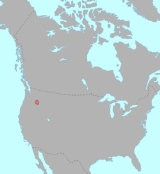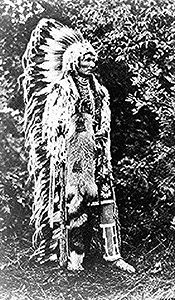
Cayuse
Encyclopedia


Native Americans in the United States
Native Americans in the United States are the indigenous peoples in North America within the boundaries of the present-day continental United States, parts of Alaska, and the island state of Hawaii. They are composed of numerous, distinct tribes, states, and ethnic groups, many of which survive as...
tribe in the state of Oregon
Oregon
Oregon is a state in the Pacific Northwest region of the United States. It is located on the Pacific coast, with Washington to the north, California to the south, Nevada on the southeast and Idaho to the east. The Columbia and Snake rivers delineate much of Oregon's northern and eastern...
in the United States
United States
The United States of America is a federal constitutional republic comprising fifty states and a federal district...
. The Cayuse tribe shares a reservation
Umatilla Indian Reservation
The Umatilla Indian Reservation is an Indian reservation in eastern Oregon in the United States, mostly located in Umatilla County, with a very small part extending south into Union County...
in northeastern Oregon with the Umatilla
Umatilla (tribe)
The Umatilla are a Sahaptin-speaking Native American group living on the Umatilla Indian Reservation, who traditionally inhabited the Columbia Plateau region of the northwestern United States....
and the Walla Walla
Walla Walla (tribe)
Walla Walla |Native American]] tribe of the northwestern United States. The reduplication of the word expresses the diminutive form. The name "Walla Walla" is translated several ways but most often as "many waters."...
tribes as part of the Confederated Tribes of the Umatilla Indian Reservation
Confederated Tribes of the Umatilla Indian Reservation
The Confederated Tribes of the Umatilla Indian Reservation is a federally recognized confederation of three Sahaptin-speaking Native American tribes who traditionally inhabited the Columbia River Plateau region: the Cayuse, Umatilla, and Walla Walla....
. The reservation is located near Pendleton, Oregon
Pendleton, Oregon
Pendleton is a city in Umatilla County, Oregon, United States. Pendleton was named in 1868 by the county commissioners for George H. Pendleton, Democratic candidate for Vice-President in the 1864 presidential campaign. The population was 16,612 at the 2010 census...
at the base of the Blue Mountains
Blue Mountains (Oregon)
The Blue Mountains are a mountain range in the western United States, located largely in northeastern Oregon and stretching into southeastern Washington...
.
The Cayuse call themselves the Tetawken, which means "we, the people".
Originally located in northeastern Oregon and southeastern Washington, they lived adjacent to territory covered by the Nez Perce. Like the Plains tribes, the Cayuse placed a high premium on warfare and were skilled horsemen, often using their horse-riding prowess to intimidate other tribes. Skilled horsemanship proved beneficial to the Indians and the neighboring cowboys who adopted the Cayuse pony
Cayuse (horse)
Cayuse is an archaic term used in the American West, usually referring to a feral or low-quality horse or pony.In British Columbia, the variant word cayoosh refers to a particular breed of mountain pony with shorter legs and large hindquarters, typically also of Indian husbandry.The origin of the...
. The Cayuse moved to the Umatilla Reservation after signing a treaty with the U.S. federal government in 1855.
History
The Cayuse Indians are a nomadic tribe that occupied territories at the heads of the Walla WallaWalla Walla River
The Walla Walla River is a tributary of the Columbia River, joining the Columbia just above Wallula Gap in southeastern Washington in the United States. The river flows through Umatilla County, Oregon and Walla Walla County, Washington. Its drainage basin is in area.-Course:The headwaters of the...
, Umatilla
Umatilla River
The Umatilla River is an tributary of the Columbia River in the U.S. state of Oregon. Draining a basin of , it enters the Columbia near the city of Umatilla in the northeastern part of the state...
, and Grande Ronde River
Grande Ronde River
The Grande Ronde River is a tributary of the Snake River, long, in northeastern Oregon and southeastern Washington in the United States. It drains an area southeast of the Blue Mountains and northwest of the Wallowa Mountains, on the Columbia Plateau...
s and from the Blue Mountains to the Deschutes River in Washington and Oregon. The tribe has always been closely associated with the neighboring Nez Percé and Walla Walla. They were considered linguistically independent. The Cayuse were known for their bravery and constant battles with the Snake and other smaller tribes. There were few pure-blood Cayuse left in 1851; intermarriage, largely with the neighboring Nez Percé, had become widespread enough that even the language was dissipating. In 1855, the Cayuse joined the treaty by which the Umatilla Indian Reservation
Umatilla Indian Reservation
The Umatilla Indian Reservation is an Indian reservation in eastern Oregon in the United States, mostly located in Umatilla County, with a very small part extending south into Union County...
was formed, and since that time have resided within the reservation's limits. Their number was officially reported as 404 in 1904; this number may be misleading, as a count in 1902 failed to discover a single pure-blooded Cayuse on the reservation and found the language almost extinct. The tribe gained wide notoriety in the early days of the white settlement of the territory. In 1838, a mission was established among the Cayuse by Marcus Whitman
Marcus Whitman
Marcus Whitman was an American physician and Oregon missionary in the Oregon Country. Along with his wife Narcissa Whitman he started a mission in what is now southeastern Washington state in 1836, which would later become a stop along the Oregon Trail...
and his wife Narcissa
Narcissa Whitman
Narcissa Prentiss Whitman was an American missionary in the Oregon Country of what would become the state of Washington. Along with Eliza Hart Spalding , she was the first European-American woman to cross the Rocky Mountains in 1836 on her way to found the Protestant Whitman Mission with husband Dr...
, at a site about seven miles from the city of Walla Walla
Walla Walla, Washington
Walla Walla is the largest city in and the county seat of Walla Walla County, Washington, United States. The population was 31,731 at the 2010 census...
. In 1847, measles brought by a rapid influx of white settlers killed off a large part of the tribe, and the Cayuse were convinced the missionaries were the cause. This, along with growing animosity due to cultural differences, resulted in the Cayuse attacking the missionaries, murdering Whitman, his wife and thirteen others. They captured 54 women and children and held them for ransom. They also destroyed the mission. This attack began the Cayuse War
Cayuse War
The Cayuse War was an armed conflict that took place in the Northwestern United States from 1847 to 1855 between the Cayuse people of the region and the United States Government and local Euro-American settlers...
. For one month three of the young girls were raped repeatedly, and the rest of the captives were forced to work and make clothing for the tribe.
The hostages were released when the Hudson's Bay Company
Hudson's Bay Company
The Hudson's Bay Company , abbreviated HBC, or "The Bay" is the oldest commercial corporation in North America and one of the oldest in the world. A fur trading business for much of its existence, today Hudson's Bay Company owns and operates retail stores throughout Canada...
brokered an exchange of 62 blankets, 63 cotton shirts, 12 Hudson Bay rifles, 600 loads of ammunition, 7 pounds of tobacco and 12 flints for the return of the now 49 surviving prisoners. The Cayuse eventually lost the war and were forced to share a reservation with the Umatilla while the whites moved onto their land.
Lifestyle
The Cayuse Indians were located in the Columbia Basin and were nomadic, even moving day by day. They lived in teepees, which many nomadic tribes used. Cayuse women would have to assemble and disassemble the teepees, either of which process could take an hour. The Cayuse were skilled horsemen, and used horses for catching animals and for their trip over the Rocky Mountains each year to bring a supply of buffalo back to their women and children. They hunted game, fished salmon, picked berries and dug roots. The women would use the animal skins for food, shelter and clothing. The men considered bravery to be an important quality, with brave warriors being held in high esteem. The strongest would be made chief. The Cayuse experienced great difficulties as white settlers moved in in large numbers following the opening of the Oregon TrailOregon Trail
The Oregon Trail is a historic east-west wagon route that connected the Missouri River to valleys in Oregon and locations in between.After 1840 steam-powered riverboats and steamboats traversing up and down the Ohio, Mississippi and Missouri rivers sped settlement and development in the flat...
in 1842, and the discovery of gold in California after 1848 and then in Eastern Oregon in 1862.
Language
The Cayuse languageCayuse language
The Cayuse language is an extinct language formerly spoken by the Cayuse Native American tribe in the U.S. state of Oregon. The Cayuse name for themselves was Liksiyu .The Cayuse language is unclassified...
is a language isolate
Language isolate
A language isolate, in the absolute sense, is a natural language with no demonstrable genealogical relationship with other languages; that is, one that has not been demonstrated to descend from an ancestor common with any other language. They are in effect language families consisting of a single...
. It has been proposed in the past that it may be related to Molala
Molala
The Molala were a people of the Plateau culture area in central Oregon, United States. Some consider them extinct, though they are one of the Confederated Tribes of the Grand Ronde Community of Oregon, with 141 of the 882 members in the 1950s claiming Molala descent.-Language:The Molalla language...
, making up a Waiilaptuan family ultimately related to the Penutian stock. This proposal is currently unproven. The language has been extinct since the 19th century.

